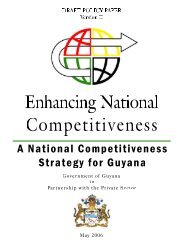Business Removing
Doing Business in 2005 -- Removing Obstacles to Growth
Doing Business in 2005 -- Removing Obstacles to Growth
- No tags were found...
Create successful ePaper yourself
Turn your PDF publications into a flip-book with our unique Google optimized e-Paper software.
62 DOING BUSINESS IN 2005<br />
In Lithuania the parties are encouraged to go into a<br />
summary proceeding, which takes a third of the regular<br />
procedure’s time. The full evidence is presented at the<br />
beginning of the trial. The old practice was to keep some<br />
evidence to the end, and use it if things went wrong. Fees<br />
for appealing the court’s judgment were increased substantially,<br />
to discourage abuse.<br />
Summary proceedings<br />
The most popular reform in 2003 was introducing summary<br />
proceedings, especially for the collection of small<br />
debt. 5 For example, in Israel the new civil procedure<br />
code incorporates a swift proceeding. Debt cases under<br />
NIS50,000 (about $12,000) are filed at the magistrate’s<br />
court. Within 45 days the debtor has to enter his defense.<br />
The court then schedules a hearing within the next 135<br />
days. The hearing cannot be postponed by anyone but<br />
the presiding judge of the court. This is rare. After the<br />
hearing the court has 14 days to issue judgment. In total<br />
the process takes less than 200 days.<br />
In Norway a similar summary procedure, previously<br />
available only for returned checks and promissory notes,<br />
is now available for debt under NOK100,000 ($15,000).<br />
In Portugal the new code allows summary proceedings:<br />
the creditor need only present the judge with evidence of<br />
the transaction and nonpayment. In the Philippines the<br />
rules for summary proceedings cover cases like a bounced<br />
check or nonpayment of a promissory note. So, debt<br />
cases no longer go through preliminary investigation before<br />
the city prosecutor, as was the case before. This cuts<br />
nearly 4 months off the debt recovery time.<br />
Two other countries sped up debt enforcement by<br />
moving it to a lower jurisdiction or out of court. In Lao<br />
PDR debt collection cases below $2,500 are now handled<br />
in the district courts. In Bangladesh the new law encourages<br />
settlement before a case enters the regular proceedings.<br />
The judge helps mediate such settlements.<br />
Enforcing judgments<br />
FIGURE 8.4<br />
Lengthy delays in enforcement<br />
Days between judgment and enforcement<br />
162<br />
Poor<br />
countries<br />
75<br />
Rich<br />
countries<br />
Source: Doing <strong>Business</strong> database.<br />
The second most popular reform in 2003 focused on enforcing<br />
judgments. In rich countries the average duration<br />
from the time the judge hands down a decision<br />
to the time the creditor gets her money back is 75 days.<br />
In middle income countries it takes 134 days. In poor<br />
countries, 162 days. In India, Jordan and Mexico enforcement<br />
accounts for more than half the debt recovery<br />
process (figure 8.4). Reforms in Austria, Colombia, Estonia<br />
and Portugal introduced stricter time limits on enforcement<br />
procedures, or allowed professionals other<br />
than court officials to do it.<br />
Setting deadlines<br />
Enforcement as a percentage<br />
of the entire debt recovery process<br />
Jordan<br />
Mexico<br />
India<br />
55%<br />
57%<br />
72%<br />
Enforcement<br />
Filing and<br />
judgement<br />
The third main type of reform—seen in Finland, Lithuania,<br />
Norway and Slovakia—puts emphasis on imposing<br />
and adhering to deadlines for filing documents and presenting<br />
arguments through case management. The<br />
Finnish experience illustrates the benefits. 6 An electronic<br />
case management system keeps track of deadlines for contesting<br />
claims or appealing judgments. If the deadline has<br />
passed, the system automatically notifies the court clerk<br />
and the plaintiff, and the case moves to the next stage. It<br />
also sets dates for court hearings. Case management in<br />
Finland has yielded other benefits as well. For cases that<br />
have remained dormant over a prescribed limit—typically<br />
9 months—the case management system sends a reminder<br />
to the presiding judge. Frequently the case has<br />
been settled out of court or the plaintiff has decided not<br />
to pursue it further. Either way, the judge can close it.<br />
In Slovakia the main reduction in delays due to case<br />
management has come from the random assignment of<br />
cases as they enter the courts. Cases are sent to whichever<br />
judge has the lightest load, ensuring faster service. Case<br />
management has reduced corruption: it makes it more<br />
difficult to know which judge to bribe for a favorable ruling.<br />
In 2002 a poll indicated that 79% of Slovaks saw judicial<br />
corruption as a major problem. In early 2004 only<br />
42% did—huge progress, even if there is a lot of room<br />
for further improvement. 7

















